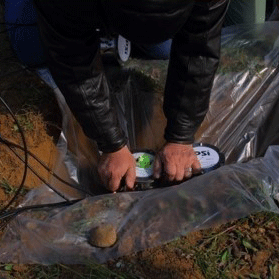Tests in Italy (2016)
 GPS Standard (GPS) invited Precision Sensors & Instruments LLC (PSI) and its sister company Global Innovations, Inc. (GII), located in Los Angeles, California to conduct field tests of the PSI seismic sensor system at their facility in Arnad, Italy and at Villa Bella, a remote site approximately 100 kilometers south of Arnad.
GPS Standard (GPS) invited Precision Sensors & Instruments LLC (PSI) and its sister company Global Innovations, Inc. (GII), located in Los Angeles, California to conduct field tests of the PSI seismic sensor system at their facility in Arnad, Italy and at Villa Bella, a remote site approximately 100 kilometers south of Arnad.
The team of five PSI/GII personnel consisted of executive management including Mr. Levon Thorose, PSI CEO and Professor Samvel Gevorgyan, PSI CTO and senior level scientists and engineers. They transported to Italy their prototype sensor system, comprised of three prototype sensor modules and one signal processor – two sensor modules contained three sensors each in an X-Y-Z coordinate axis configuration and one module that contained two scalar sensors configured in Z direction.
The Italian team represented three distinct organizations totaling six personnel: (1) GPS Standard executive management including Mr. Pietro Capula, President and Mr. Gallina Bruno, CEO and senior level scientists and engineers, (2) Dr. Donato Battaglino, proposal engineer for prime contractor Page Europa and (3) GPS’s technical consultant and Professor at Turin Polytechnic University, Dr. Riccardo Maggiora.
Results and conclusion of the tests
Foot-step detection is a far more stringent detection criteria for ground level detection of seismic activities. The countable foot-step detection is the most rigorous detection criteria, which not all manufacturers of ground sensor products commit to, or even measure. PSI/GII team has set the foot-step accountable detection criteria in order to show PSI sensor’s superior detection capability.
Sensor hardware performed as advertised with 110 meter detection capability achieved on day two of the testing at the remote test site even with severe background seismic activities (GLEA: Ground Level Environmental Activity) originating from moderate winds coupled with trees, and the main motorway 800 meters distant. If the winds were less and/or the motorway more distant, the detectable distance would have been significantly increased to perhaps 250 meters.
All in attendance during the day two field tests agreed that the current post processing software utilized with this revolutionary sensor hardware is insufficient. However, by applying current state of the art software algorithms and its associated digital signal processing hardware, not only will the detection capability of the PSI seismic sensor be available in real time, it will also have significantly longer detection distance capability based on vastly improved filtering algorithms. A doubling or tripling of detection distance is quite possible thus leading to a capability for early warning border security detection unmatched worldwide.
The GII/PSI team is well aware of the lack of real-time monitoring shortcomings and fully committed to bringing its capability to the corresponding level of the sensor hardware. However, it must be emphasized that the current PSI sensor hardware capability vastly outperforms the capabilities of the current geophone technology even when utilizing insufficient rudimentary software. That conclusion was clearly made on March 24th, the second day of field testing and meets the goals of the four day gathering.